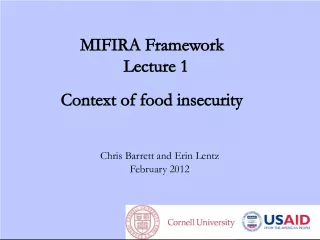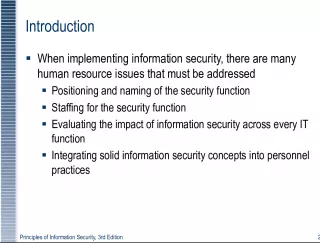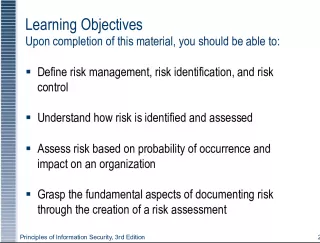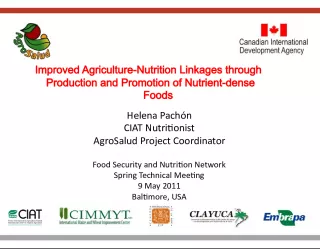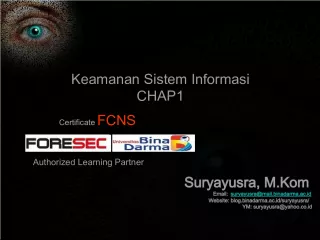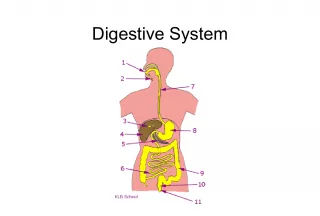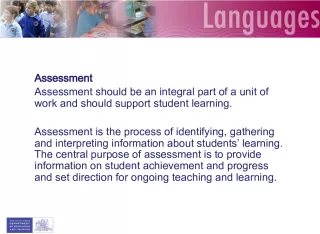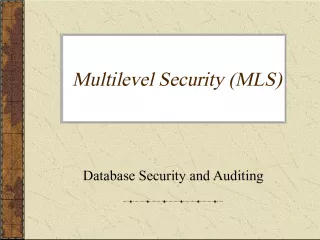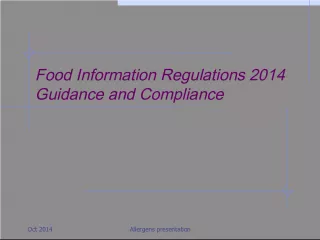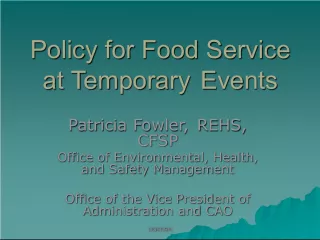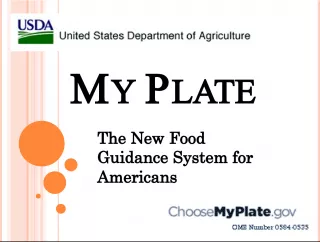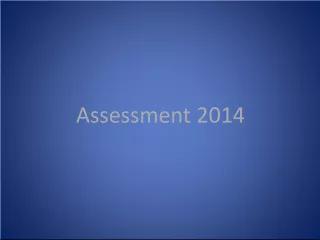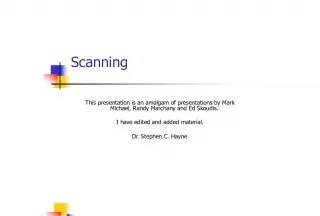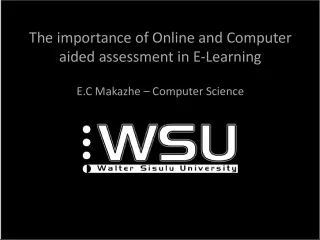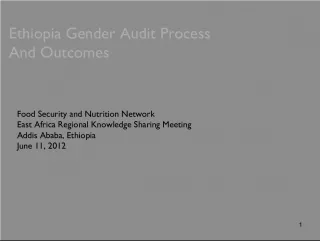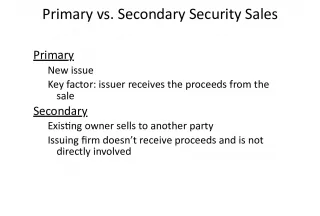Understanding Food Security Fundamentals and Needs Assessment
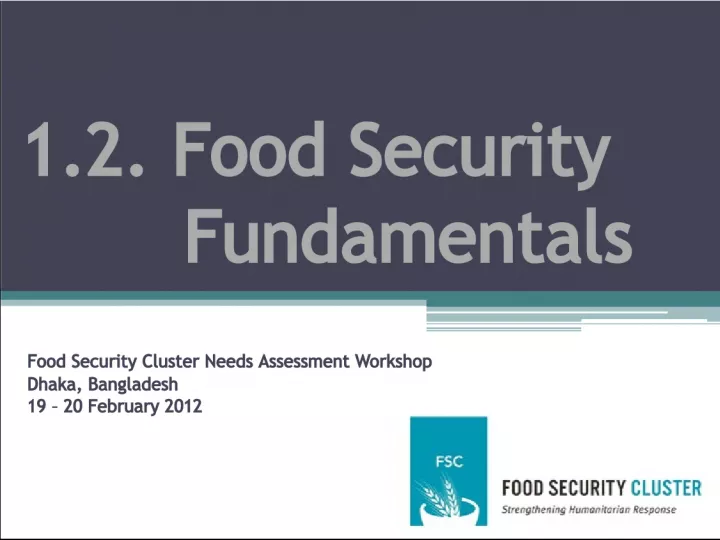

This workshop focuses on the basics of food security and how to assess needs for addressing food insecurity. Participants will learn about key concepts such as availability, access, and resilience and the key components of a food and nutrition security framework.
- Uploaded on | 6 Views
-
 arlena
arlena
About Understanding Food Security Fundamentals and Needs Assessment
PowerPoint presentation about 'Understanding Food Security Fundamentals and Needs Assessment'. This presentation describes the topic on This workshop focuses on the basics of food security and how to assess needs for addressing food insecurity. Participants will learn about key concepts such as availability, access, and resilience and the key components of a food and nutrition security framework.. The key topics included in this slideshow are food security, needs assessment, availability, access, resilience,. Download this presentation absolutely free.
Presentation Transcript
1. 1.2. Food Security Fundamentals Food Security Cluster Needs Assessment Workshop Dhaka, Bangladesh 19 20 February 2012
2. Session Objectives After this session, participants should be able to: Define a number of key food security concepts, including availability, access, utilisation, stability, livelihoods, coping, and resilience Explain the chief differences between chronic and transitory food insecurity Identify the key components of the food and nutrition security conceptual framework
3. Food Security defined Food security exists when all people, at all times, have physical and economic access to sufficient, safe and nutritious food that meets their needs and food preferences for an active and healthy life [ World Food Summit Plan of Action, paragraph 1, 1996 ]
4. The Pillars of Food Security
5. Availability the amount of food of appropriate quality physically present in the area, and is expected to become available in that area may be aggregated at the national, provincial, district or community level. Food availability is determined by: production : food produced in the area stocks : food held by traders, in government reserves [and at farm level] in the area trade : food brought into (and taken out of) the area through market mechanisms bulk transfers : food brought into the area by the government and/or aid agencies
6. Access (of households in specific population groups) The ability of households (in specific population groups ) to regularly acquire adequate amounts of appropriate food for a nutritious diet Means of access may include: own production of crops, livestock or farmed fish hunting, fishing or gathering wild foods purchases at markets, shops, etc. barter exchange exchange of items for food gifts from friends, relatives, community, transfers from government or aid agencies (relief or safety net programmes), food-for-work, cash/vouchers, etc.
7. Utilisation The use that households make of the food to which they have access, and individuals ability to absorb and metabolize the nutrients. Food utilization depends on: how food is stored, processed and prepared (including the water and cooking fuel available, and hygiene practices) feeding practices, particularly for special needs individuals: the young & elderly; the sick; pregnant & lactating women sharing of food within the household; the extent to which this meets individuals nutritional needs growth, pregnancy, lactation, etc. health status of each household member
8. Stability consistency and reliability of food availability and access Stability means households should not risk losing access to food as a consequence of sudden shocks or cyclical events.
9. Livelihoods the capabilities, assets, and activities required for a means of living linked to survival and (future) well-being. Livelihood strategies are the practical means or activities through which people access food and other necessaries, or income to buy them. Coping activities that people resort to temporarily in order to obtain food, income and/or services when their normal means of livelihood have been disrupted Resilience the capacity to withstand and recover from food security shocks
10. 10 impact of shock on human, financial, social, physical, & natural, assets (agricultural, livestock, etc. impact of policies, institutions, other processes strategies the affected are using to survive tries to determine likely outcomes for the affected: changes in vulnerability, food / nutrition security status, etc. A livelihoods approach examines:
11. Chronic Food Insecurity A long-term or persistent inability to meet minimum food requirements Without appropriate attention, can lead to: STUNTING Transitory Food Insecurity A short-term or temporary inability to meet minimum food requirements, indicating a capacity to recover Without appropriate attention, can lead to: WASTING Temporal aspects of food insecurity
12. Temporal aspects & severity of food insecurity
13. Negative synergies between chronic & transitory food insecurity Transitory can become chronic: repeated crises can lead households towards chronic food insecurity Moderate chronic can become severe chronic: Households in chronic food insecurity are more vulnerable to deterioration due to crisis, compared to those who are in transitory food insecurity
14. Impact of crises on resilient households Exposure to shocks Exposure to shocks
15. Impact of crises on vulnerable households
16. Food & Nutrition Security Conceptual Framework: Key Concepts Livelihoods Food security Nutrition security
17. Food and Nutrition Security Conceptual Framework
18. Productive Resources Productive Resources Formal & Informal Infrastructure Formal & Informal Infrastructure Political Ideology Political Ideology Immediate Immediate Underlying Underlying Basic Basic Malnutrition Malnutrition Inadequate Food Intake Inadequate Food Intake Disease Disease Household Food Security Household Food Security Social & Care Environment Social & Care Environment Access to Health Care & Health Environment Access to Health Care & Health Environment Causes Causes Focuses on causal analysis: as in the UNICEF Malnutrition Framework
19. 19 Conceptual Framework: levels of analysis (1) Basic causes: Basic causes: structural factors that establish the context in which malnutrition and food insecurity exist structural factors that establish the context in which malnutrition and food insecurity exist
20. 20 Underlying causes: Underlying causes: characteristics of individual households that make them more, or less, susceptible to malnutrition and food insecurity characteristics of individual households that make them more, or less, susceptible to malnutrition and food insecurity Conceptual Framework: levels of analysis (2)
21. Conceptual Framework: levels of analysis (3) Immediate causes: Immediate causes: factors that can lead directly to malnutrition and death factors that can lead directly to malnutrition and death
22. 22 Conceptual Framework: levels of analysis (4) Outcomes: Outcomes: malnutrition and excess mortality arising from failure to resolve problems at other levels malnutrition and excess mortality arising from failure to resolve problems at other levels
23. Wrap-up Food security = stable food availability, access and utilisation Distinguishing between chronic and transitory food security is important for understanding the potential impact of food security response options A livelihoods approach orients the planning and design of the assessment, as well as targeting the response options The food and nutrition security conceptual framework helps to guide the planning design of food security assessments
